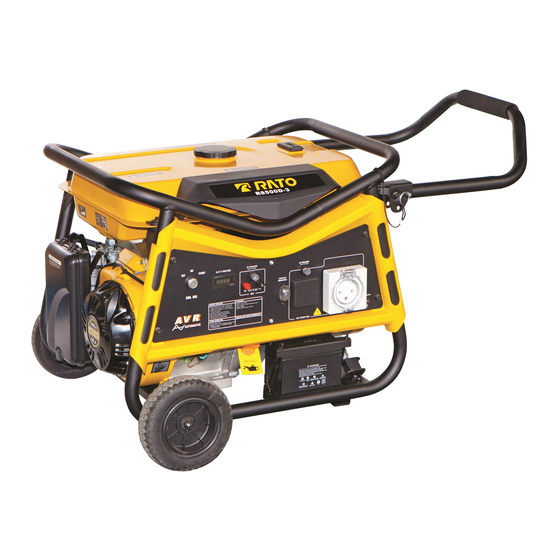
Table of Contents
Advertisement
Advertisement
Table of Contents

Subscribe to Our Youtube Channel
Summary of Contents for Rato R8500D-3
- Page 1 GENERATOR Owner’s Manual...
-
Page 10: Component Identification
COMPONENT IDENTIFICATION 2. COMPONENT IDENTIFICATION VOLTAGE METER GENERATOR SWITCH AC RECEPTACLES CHOKE LEVER GROUND TERMINAL RECOIL STARTER GRIP OVERCURRENT PROTECTOR DC TERMINAL POSTS FUEL TANK CAP FUEL TANK CARBURETTOR MUFFLER... - Page 11 COMPONENT IDENTIFICATION 2kW/2.3kW/2.5kW/2.8kW AC RECEPTACLES VOLTAGE METER GENERATOR OVERCURRENT SWITCH PROTECTOR CIRCUIT CHOKE LEVER BREAKER GROUND TERMINAL RECOIL STARTER GRIP DC TERMINAL POSTS FUEL TANK CAP FUEL TANK CARBURETTOR MUFFLER...
- Page 12 COMPONENT IDENTIFICATION 5kW/5.5kW/6.5kW/7kW/8kW RECEPTACLES VOLTMETER GENERATOR SWITCH OVERCURRENT PROTECTOR CHOKE LEVER CIRCUIT BREAKER AIR CLEANER FUEL VALVE GROUND TERMINAL RECOIL STARTER GRIP BATTERY DC TERMINALS FUEL TANK FUEL TANK CAP MUFFLER CARBURETTOR...
-
Page 15: Fuel Valve
CONTROL 3. Fuel Valve sure to return the lever to “OFF” after stopping the engine. FUEL VALVE 4. Choke Lever The choke lever is used to provide an enriched fuel mixture when starting a cold engine. Slowly put the choke lever to “OPEN” position after the engine is heated. -
Page 16: Circuit Breaker
CONTROL 5. AC Circuit Breaker/Overcurrent Protector The overload current will automatically switch off circuit breaker to avoid short circuit of the load or overload. If the indicator of AC Overcurrent Protector is raised, the Overcurrent Protector is now in the “OFF” position. Press the button of AC Overcurrent Protector to the “ON”... - Page 17 : ...
-
Page 18: Generator Grounding
GENERATOR OPERATION 2. Generator Grounding To prevent electrical shock or misuse from faulty appliances, the generator should be grounded with insulated lead. 3. AC Current Before starting the generator, make sure that. Total load appliance power (Total resistance, capacitive and inductive) does not exceed rated power of the generator. - Page 19 GENERATOR OPERATION In general, capacitive and inductive load, especially, motor-driven devices have a big starting current when starting. The following table is a reference for when connecting to the electric appliances Wattage Examples Type Typical Device Start Rated Device Starting Rated Incandescent Incandescent Lamp 100VA...
-
Page 27: Maintenance
8. MAINTENANCE The engine must be properly maintained to ensure its operation be safe, economy and trouble-free, as well as eco-friendly. In order to keep your gasoline engine in good working condition, it must be periodically serviced. The following maintenance schedule and routine inspection procedures must be carefully followed Frequency Thereafter, every... -
Page 28: Engine Oil Change
MAINTENANCE every 25 hours. should govern. If you have missed the scheduled time to maintain your engine, do it as soon as possible. Stop the engine before servicing. Put the engine on a level surface and remove the spark plug cap to prevent the engine from starting. Never run your engine in a poorly ventilated room or other enclosed area, be sure to keep good ventilation in working area. -
Page 35: Wiring Diagram
WIRING DIAGRAM 11. WIRING DIAGRAM Recoil... - Page 36 WIRING DIAGRAM...
- Page 37 WIRING DIAGRAM 2.3kW/2.5kW/2.8kW...
- Page 38 WIRING DIAGRAM 5kW/5.5kW/6.5kW/7kW/8kW...
- Page 39 WIRING DIAGRAM Recoil / Electric Starter 2kW/2.3kW/2.5kW/2.8kW...
- Page 40 WIRING DIAGRAM 5kW/5.5kW/6.5kW/7kW/8kW...
-
Page 41: Specifications
SPECIFICATIONS 12. SPECIFICATIONS Item 2 kW 2.3 kW 2.5 kW 2.8 kW Gasoline Engine Style R100 R200L R200L R200L R210 Single Cylinder, 4-Stroke, Forced Air Gasoline Engine Type Cooling, OHV Displacement (cc) Gasoline Igniting System Transistorized Magneto Engine Fuel Volume (L) Fuel Consumption(g/(kW·h)) Continuing Time (hr) Oil Capacity (L) - Page 42 8 kW Recoil/ Electric Starter...
- Page 48 93004-YE70210...















Need help?
Do you have a question about the R8500D-3 and is the answer not in the manual?
Questions and answers